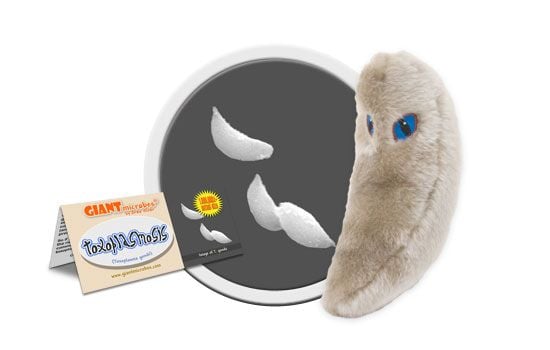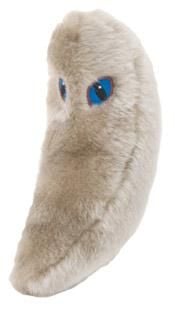Toxoplasmosis (Toxoplasma gondii)
Product Details
Additional Information
| Sizes | Giantmicrobes are based on actual microbes, cells, organisms and other critters, only 1,000,000 times actual size! Gigantic (GG) 16-24" XL (XL) 10-15" Original (PD) 5-8" Keychain (KC) 2-4" with clip |
|---|---|
| Materials | Plush from all new materials. Stuffed with polyester fiber fill. Surface washable: sponge with water & soap, air dry. |
| Packaging | Each plush microbe includes a printed card with fun, educational and fascinating facts about the actual microbe or cell. |
| Safety | Every product meets or exceeds U.S. and European standards for safety. For ages 3 and up. |
All about Toxoplasmosis (Toxoplasma gondii)
FACTS: Toxoplasmosis is an extremely common parasitic disease caused by the toxoplasma gondii protozoan. Large percentages of the world’s population are infected!
One of the most common food-borne illnesses, toxoplasmosis can be acquired by eating undercooked meat (particularly lamb and pork), or underwashed fruits and vegetables. But toxoplasmosis is typically associated with cats as cats are the primary host for the reproductive stage of the parasite.
T. gondii oocysts (egg-like forms) mature in the bowels of infected cats. After they are expelled, they can be acquired by almost any warm-blooded animal, as well as humans. Cats commonly contract their infections after catching small warm-blooded animals such as mice and birds which have previously caught the parasite – and the cycle continues.
In most cases, T. gondii infections produce either no symptoms or common flu-like symptoms; many people never know that they’ve gotten one. However, toxoplasmosis can be dangerous for those with impaired immune systems. And T. gondii infections are of particular concern to pregnant women who have not been previously infected (and therefore acquired immunity) as complications ranging from premature births to congenital defects can result.
So if you’re at risk, don’t play cat-and-mouse with T. gondii: reduce the risk of infection by keeping cats indoors, feeding them processed, commercial food – and avoiding litter boxes. And don’t give toxoplasmosis a chance to pounce.
| Name | Toxoplasma Gondii |
|---|
| Actual Size | Cysts are 5 to 50 microns in diameter |
|---|
| Where It Lives | Cats are able to spread toxoplasma through their feces (Cats are the only known definitive hosts). In humans, toxoplasmosis creates cysts in the skeletal muscle, myocardium, brain, and eyes. |
|---|
| Symptoms | Most people with toxoplasmosis don’t get any symptoms! For some, toxoplasmosis may feel like the flu, with swollen lymph glands or muscle aches and pains that last for a month or more. |
|---|
| Cure | Treatment is usually not needed for an otherwise healthy person who is not pregnant. Symptoms typically go away in a few weeks or months. If pregnant, however, there are medications available. |
|---|
| History |
In 1908, toxoplasma gondii was first discovered in a North African rodent. During the same year toxoplasma gondii was found in the tissues of a rabbit in Brazil. In 1939, toxoplasma gondii was found in the tissues of a congenitally infected infant (congenital disorders defect human fetuses). In 1957, toxoplasma gondii caused an abortion storm among sheep. |
|---|
| Fascinating Facts | Toxoplasmosis is the second leading cause of death from food borne illness in the United States! |
|---|






